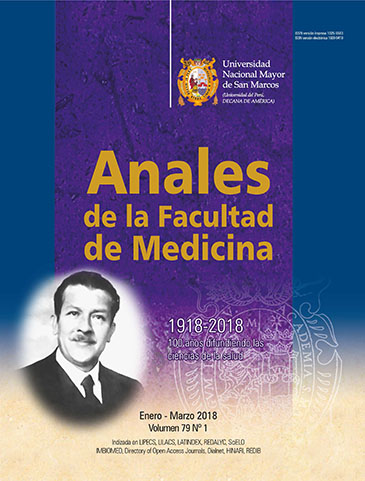Frecuency and characteristics of obese subjects with and without cardiometabolic risk
DOI:
https://doi.org/10.15381/anales.v79i1.14586Keywords:
Patients, Risk, Obesity, Cholesterol, Tryglicerides, HypertensionAbstract
Objetive. To study the frequency and characteristics of an obese population with and without cardiometabolic risk (CMR) and, to revise the concept of cardiometabolically healthy obese CMHO subjects. Material and methods. A total of 105 obese subjects, 30 to 75 years old, were recluted from a preventive-promotional program from may 2015 to april 2016. Previous informed consent, age, gender, anthropometric measures, blood pressure (BP), personal and family history of cardiovascular risk factors (CVRF) were registered. At fasting glucose (G), total cholesterol (TC), HDL cholesterol (cHDL), triglycerides (Tg), creatinine, plasma proteins, bilirrubins, transaminases (AST,ALT), alkaline fosfatase (FA) and gamaglutamyltranspeptidase (GGTP) were measured in blood by conventional methods. VLDL, LDL, Non-HDL fractions were calculated. Statistics were calculated with SPSS.23 program. Results. 77,4% were women, mean age 51±0,86 years. Women had lower height, weight and abdominal circumference than male but higher HDL concentration, other parameters were similar. Obesity grade I was found in 45,7%, grade II in 24,7% and grade III in 29,5%. Dislipoproteinemia had 89,2% of women and 87% of men; high blood pressure (HBP): women 20,7%, men 21,4%; tobaccoism women 5,5%, male 42,3%; hyperglycemia: women 14,2%, men 14,2%; macrosomia/low birthweight: women 6,94%, men 0%; elevated hepatic enzymes: women 29,8%, male 32,1%. 9,52% were CMHO since they had normal BP, G. HDLc, Tg, LDLc and Non-HDL . Conclusions. The majority of obese patients had CMR, only 10 (9,5%) were CMHO.Downloads
Published
2018-06-07
Issue
Section
Artículo Original
License
Copyright (c) 2018 Anales de la Facultad de Medicina

This work is licensed under a Creative Commons Attribution-NonCommercial-ShareAlike 4.0 International License.
Those authors who have publications with this magazine accept the following terms:
- Authors will retain their copyrights and guarantee the journal the right of first publication of their work, which will be simultaneously subject to Creative Commons Attribution License that allows third parties to share the work as long as its author and its first publication this magazine are indicated.
- Authors may adopt other non-exclusive licensing agreements for the distribution of the version of the published work (eg, deposit it in an institutional electronic file or publish it in a monographic volume) provided that the initial publication in this magazine is indicated.
- Authors are allowed and recommended to disseminate their work over the Internet (eg: in institutional telematic archives or on their website) before and during the submission process, which It can produce interesting exchanges and increase quotes from the published work. (See El efecto del acceso abierto ).
How to Cite
1.
Garmendia F, Pando R, Hernández M. Frecuency and characteristics of obese subjects with and without cardiometabolic risk. An Fac med [Internet]. 2018 Jun. 7 [cited 2025 Jun. 2];79(1):11-6. Available from: https://revistasinvestigacion.unmsm.edu.pe/index.php/anales/article/view/14586



